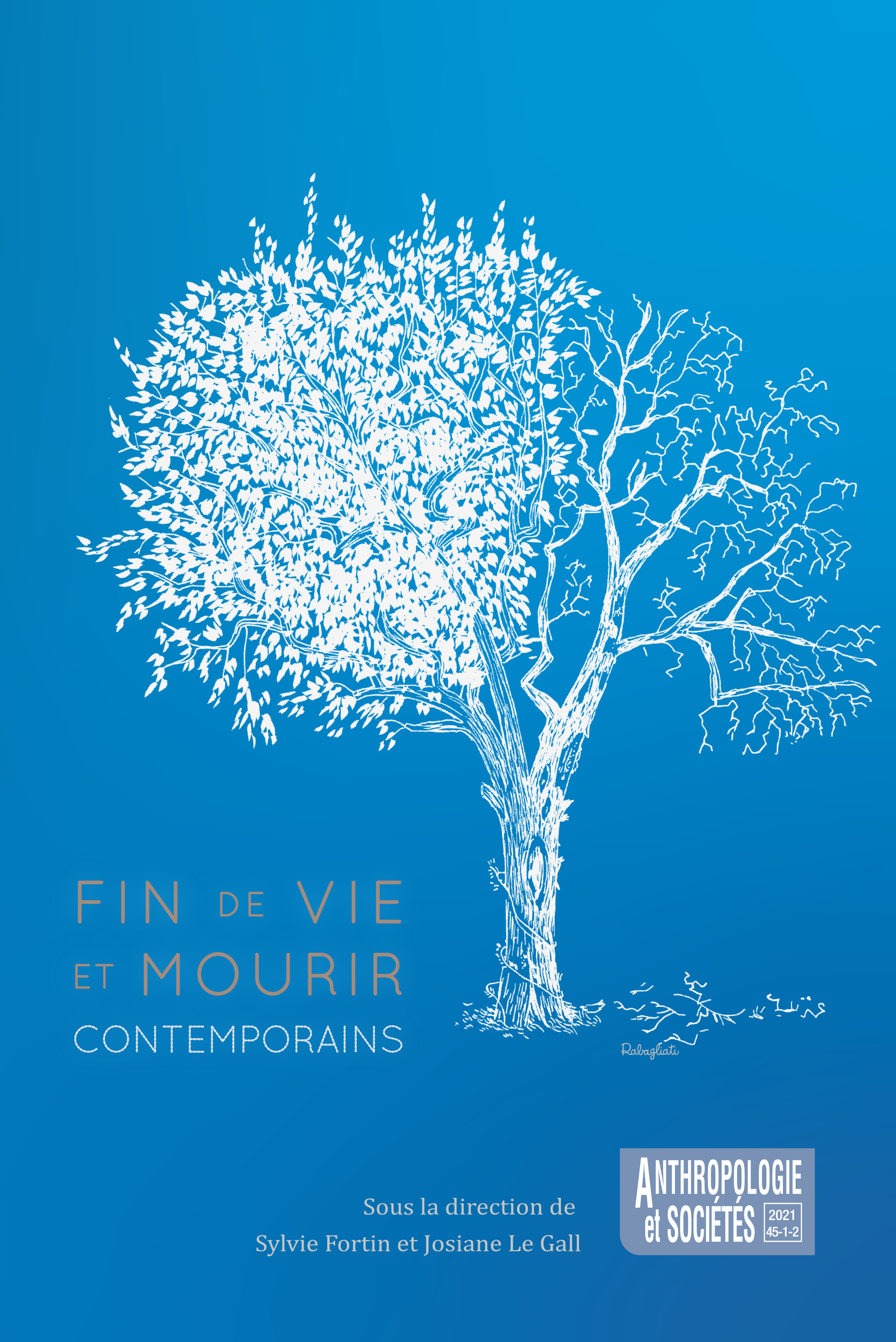Abstracts
Résumé
Cet essai examine deux changements importants que subissent le mourir et la mort dans le monde pluriforme et sécularisé d’aujourd’hui. Le premier changement met en scène l’autonomie, les souhaits d’autonomie nourris pendant la vie s’étendant désormais au moment et à la manière de mourir. L’euthanasie permet à une personne d’éviter la condition douloureuse et difficile qui précède la fin de vie. Un second changement majeur est que ceux qui meurent et ceux qui restent peuvent nourrir des croyances et des attentes différentes concernant ce qui se passe au moment de la mort et après. Dans le monde chrétien, par exemple, les rituels plutôt uniformes qui étaient pratiqués avant et après la mort ne reflètent plus les croyances d’un grand nombre de personnes confrontées à la mort aujourd’hui. Ce bref essai explore l’imbrication de ces deux évolutions relatives à la mort et au mourir dans la société actuelle, en mettant l’accent sur le pays de l’auteur, les Pays-Bas.
Mots clés:
- van der Geest,
- rituel,
- mort,
- mourir,
- euthanasie,
- authenticité,
- autonomie,
- Pays-Bas
Abstract
This essay looks at two significant changes that dying and death are undergoing in today’s pluriform and secularizing world. One is that wishes of autonomy during life are now increasingly being extended to autonomy over when and how to die. Through euthanasia a person can decide to avoid the painful and miserable condition that precedes the end of life. A second major change is that those who die and those who stay behind may have diverse beliefs and expectations about what happens at and after death. The rather uniform rituals that used to be performed before and after death in, for instance, the Christian world does no longer reflect the beliefs of a large number of people who face death today. This brief essay explores the intertwinement of these two developments around death and dying in today’s society, with a focus on the country of the author, the Netherlands.
Keywords:
- van der Geest,
- ritual,
- death,
- dying,
- euthanasia,
- authenticity,
- autonomy,
- the Netherlands
Resumen
Este ensayo analiza dos cambios importantes que experimentan la muerte y el morir en el mundo pluriforme y secular de hoy en día. El primer cambio pone en escena la autonomía, los deseos de autonomía cultivados a la largo de la vida y que ahora se prolongan al momento y a la manera de morir. La eutanasia permite a una persona evitar la condición dolorosa y difícil que precede el fin de la vida. El otro cambio significativo es que quienes mueren y quienes permaneces pueden albergar creencias y expectativas diferentes sobre lo que sucede en el momento de morir y después. En el mundo cristiano, por ejemplo, los ritos, más bien uniformes que se practican antes y después de la muerte ya no reflejan las creencias de un gran número de personas que hoy en día confrontan la muerte. Este breve ensayo explora la imbricación de estas dos evoluciones relacionadas con la muerte y el morir en la sociedad actual, poniendo de relieve el país del autor, Holanda.
Palabras clave:
- van der Geest,
- rito,
- muerte,
- morir,
- eutanasia,
- autenticidad,
- autonomía,
- Holanda
Appendices
Références
- BBC News, 2019, « Assisted Dying: Australian Cancer Patient First to Use New Law », mis en ligne le 5 août 2019, consulté sur Internet (https://www.bbc.com/news/world-australia-49230903), le 28 mai 2020.
- Berkvens-Stevelinck C., 2007, Vrije rituelen: Vorm geven aan het leven [Free Rituals: Giving Shape to Life]. Zoetermeer, Meinema.
- de Beauvoir S., 1964, Une mort très douce. Paris, Gallimard.
- Emanuel E. J., 2014, « Why I Hope to Die at 75 », The Atlantic, octobre 2014. Consulté sur Internet (https://www.theatlantic.com/magazine/archive/2014/10/why-i-hope-to-die-at-75/379329/), le 28 mai 2020.
- Fortuin N. P. M., J. B. A. M. Schilderman et E. Venbrux, 2017, « Death and the Search for Meaning: Canonical, Utilitarian and Expressive Thanatological Cultural Niches », Mortality, 22, 4 : 339-355.
- Klasen H., 1990, Die alten Niha und ihre Einstellung zu Krankheit und Tod [The Elderly Niha and Their Attitude to Sickness and Death]. Papenberg, Verlag Eissing.
- Lam H., 1997, Helpen bij sterven. Levensbeëindiging op verzoek in verschillende samenlevingen [Helping to Die: Termination of Life on Request in Various Societies]. Amsterdam, Boom et Overveen, Belvédère.
- Liégeois A., 2008, « Sacramenten voor zondaars? Over de ziekenzalving aan mensen die om euthanasie vragen [Sacraments for Sinners? About Ointment of the Sick for People Requesting Euthanasia] » : 257-268, in T. Knieps-Port Le Roi et L. Boeve (dir.), Gods sacramentele aanwezigheid in de wereld van vandaag [God’s Sacramental Presence in Today’s World]. Louvain et Voorburg, Acco.
- Lienhardt G., 1961, Divinity and Experience. Oxford, Clarendon Press.
- Rose S., 2001, « Is the Term “Spirituality” a Word That Everyone Uses, but Nobody Knows What Anyone Means by It? », Journal of Contemporary Religion, 16 : 193-207.
- Seale C. et S. van der Geest, 2004, « Good and Bad Death: Introduction », Social Science & Medicine, 58, 5 : 883-886.
- van der Geest S. et P. Satalkar, 2019, « Autonomy and Dying: Notes About Decision-Making and “Completed Life” Euthanasia in the Netherlands », Death Studies, 45, 8 : 613-622. Consulté sur Internet (DOI : 0.1080/07481187.2019.1671543), le 28 mai 2020.
- Van Wijngaarden E. J. (dir.), 2020, Perspectieven op de doodswens van ouderen die niet ernstig ziek zijn: De mens en de cijfers [Perspectives on the Death Wish of Older People Who Are Not Seriously Ill: The People and the Numbers]. The Hague, ZonMw.
- Vandendorpe F., 2000, « Funerals in Belgium: The Hidden Complexity of Contemporary Practices », Mortality, 51, 1 : 18-33. Consulté sur Internet (DOI : 10.1080/713685989), le 28 mai 2020.

